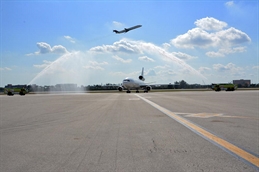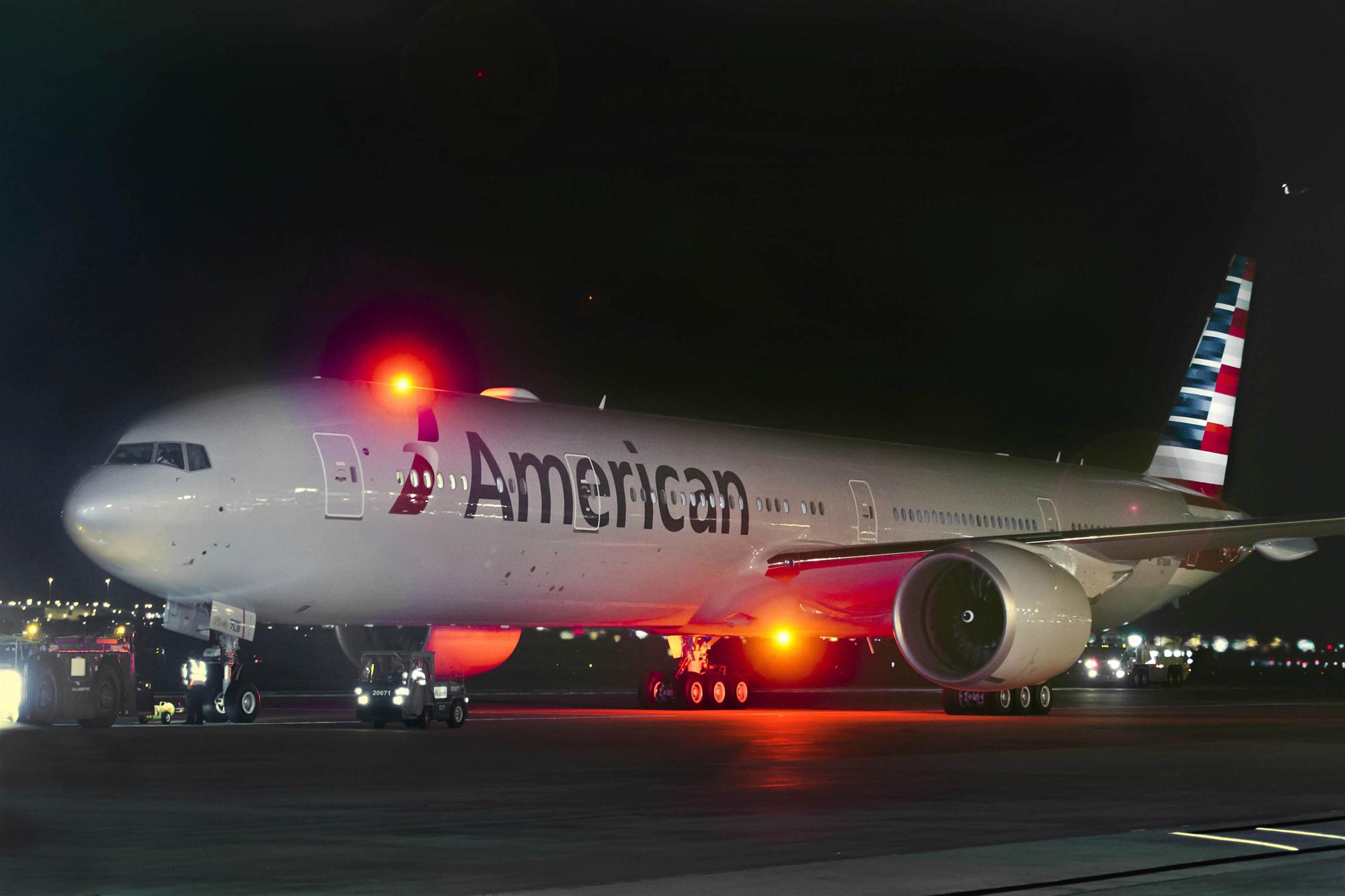
Air freight between Asia and South America seems to be holding its own, despite numerous setbacks in each of the two regions’ largest economies, such as China’s stock market turmoil and the depreciation of both the Brazilian real and the Chinese yuan.
Jim Butler, president of American Airlines Cargo, says that the carrier performed “incredibly well” out of Asia in the first half of the year.
“We found that, while we were well above where we had planned to be and saw some very good growth, there was more terminating traffic to the US than we were used to seeing down to Latin America,” says Butler. “It’s essentially because of what’s happening both from a currency perspective and from an economic perspective down in deep South America. We still saw some good traffic, although we’re looking forward to the economies of Argentina and Brazil, as well as some of the other countries, strengthening over the coming months and years.”
AA has gradually been building up its network in Asia. It now flies from Dallas/Fort Worth to Beijing, Hong Kong, Seoul, Shanghai and Tokyo Narita, from Chicago to Beijing, Shanghai and Tokyo Narita, and from Los Angeles to Beijing and Tokyo Narita. Another Los Angeles-Tokyo Haneda flight is scheduled to start in October 2015, while a Los Angeles-Sydney flight will launch in December 2015.
“We’ve seen incredible growth in the number of services that we offer daily, especially to China,” says Butler. “We’ve got good growing capacity and so we’ve seen a little bit of softness, but we’re still flying some fantastic loads into and out of China, with a lot of it going to Latin America.”
But it’s not just AA that has been taking advantage.
Turkish Airlines has also enjoyed growth in the Asia-South America market. Halit Anlatan, vice president of sales and marketing at Turkish Cargo, attributes this growth to the boom in charters from Japan due to the US West Coast port strike, new capacity from Vietnam and other Southeast Asian countries, and new traffic between Hong Kong and Latin America.
Turkish Airlines flies from Istanbul to Buenos Aires via São Paulo with Boeing 777-300ERs.
“With the contribution of 5th freedom traffic rights four our flights between Argentina and Brazil, Turkish Cargo has reached significant market share in Latin America,” says Anlatan. “In addition to this, we did not only have scheduled belly capacity from and to the Americas, but also freighter capacity via charter flights, which makes Istanbul a fulcrum in terms of cargo travelling between Asia and South America.”
The airline is also scheduled to launch services to Miami on October 25, 2015.
Anlatan says that Miami holds strategic value for cargo because it is considered the connecting hub for all of Central and South America.
“From Turkish Airlines’ perspective, launching Miami as an online point is the first advantage to connecting to Latin America,” says Anlatan. “Currently, we operate as an offline carrier from Miami and some Latin American countries such as Colombia, Ecuador, Mexico, Chile and Uruguay. From Miami, we can capitalize on established markets via interline agreements from an outbound standpoint. Finally, with the support of our offline markets, we can better serve markets that are considered niche to Turkish Airlines such as the CIS countries, Africa and the Middle East.”
Miami-Dade Aviation Department is continuously working hard to promote cargo air links between Asia and Latin America via Miami International Airport.
“When these services commenced, we saw inbound loads with high-technology goods from China greatly imbalance the two-way trade flow from South America in terms of volume,” says Chris Mangos, marketing director at Miami-Dade Aviation Department. “We have seen that the marketing of these services has helped the flow of perishable products from South America – particularly fruits, vegetables and seafood – grow significantly in demand over time. With Latin America’s opposite growing and harvest season, and the well-received product mix now flowing to Asia, the carriers involved in the transfer of goods are seeing more balanced loads.”
As a further sign of Miami International Airport’s appeal, particularly in the cargo market, Mangos highlights the fact that three airlines have launched or announced freighter services to the airport within the past year.
Western Global Airlines, a low-cost all-cargo carrier based in Florida, started MD-11F charter operations to Latin America in November 2014.
In April 2015, Venezuelan carrier Transcarga International Airways became the 40th all-cargo airline to serve Miami when it began services to and from Caracas with an Airbus A300-B4 freighter.
OceanAir, also known as Avianca Brazil, also announced recently that it would be launching three-weekly cargo flights on September 18, 2015 from Lima or Santiago with its sole Airbus A330 Freighter. Mangos says that schedules for the second and third months of operation show additional origin points in Brazil and the rest of South America.
Miami International Airport is a major hub for American Airlines, which operates more than 300 flights a day to more than 120 destinations.

“Miami is the heart and lifeblood of everything we do in Latin America,” says Art Torno, senior vice president of international and cargo at AA. “It’s the preferred gateway by far for customers, meaning that it becomes our largest cargo hub in the world. Our focus is to continue to strengthen it, maintain it as one of the absolute diamonds of the network for both passengers and cargo, and look at ways to improve and invest in the infrastructure.”
AA flies to 10 destinations in Brazil every day, the newest one being Viracopos International Airport, which was started in December 2014 with a Boeing 767-300ER.
“It’s a top destination for our cargo customers and it’s the breadth that we’ve built through the Miami hub that has allowed us to serve an airport like that,” says Butler. “Of all the things we’ve announced, I got more phone calls the day we announced that one than I have in a long time.”
Turkish Airlines, meanwhile, has plans of its own to expand its presence in Latin America, with countries such as Mexico, Colombia, Venezuela and Cuba being candidates.
“From the mentioned countries, we would consider Mexico and Colombia in terms of cargo because of the perishable flower market and the electronic and automotive industries,” says Anlatan. “Turkish Airlines can take a respective share in these markets. The cargo sector works parallel with the passenger side in terms of vision and objectives, and the introduction of more widebody aircraft to the fleet contributes to both passenger and cargo.”
Anlatan says that he and his team will have to overcome cost inefficiencies and market saturation, particularly with many European legacy carriers that established a presence in Latin America much earlier than Turkish Airlines.
“We will overcome such challenges with our strategy of operating large and cost-efficient aircraft,” he says. “From a service perspective, we will provide alternative solutions. One of our main advantages is that we are a connector between Europe and the Middle East. We are also very strong in Africa and CIS countries. Together with our new cargo facility and new software, that will give us the momentum to build a solid base to start operations.”
As for American Airlines, one of the foremost challenges is now to bring the business up to date in terms of technology. The company has spent much effort and time on the process of integrating US Airways into the airline after the two merged in December 2013.
“We need to get off of paper and onto electronic air waybills and, more importantly, electronic freight,” says Butler. “It’ll allow us to continue to innovate, operate more efficiently and get a better product to our customers. Ultimately, what we need to do right now is modernize the cargo business.”
Butler says he will have to face currency and macroeconomic challenges in the near future such as the issues surrounding the Argentinian, Brazilian and Chinese economies, but in the long term, he says he is “very bullish” overall.
“I feel a very different air this year than I did last year,” he says. “Last year, there was a lot of resistance to change and things like the air waybill but this year, I feel like the industry is on the cusp of really getting to the point where we can modernize and innovate such that we can better compete in the global logistics business.”
By Jeffrey Lee
Asia Cargo News | Hong Kong




